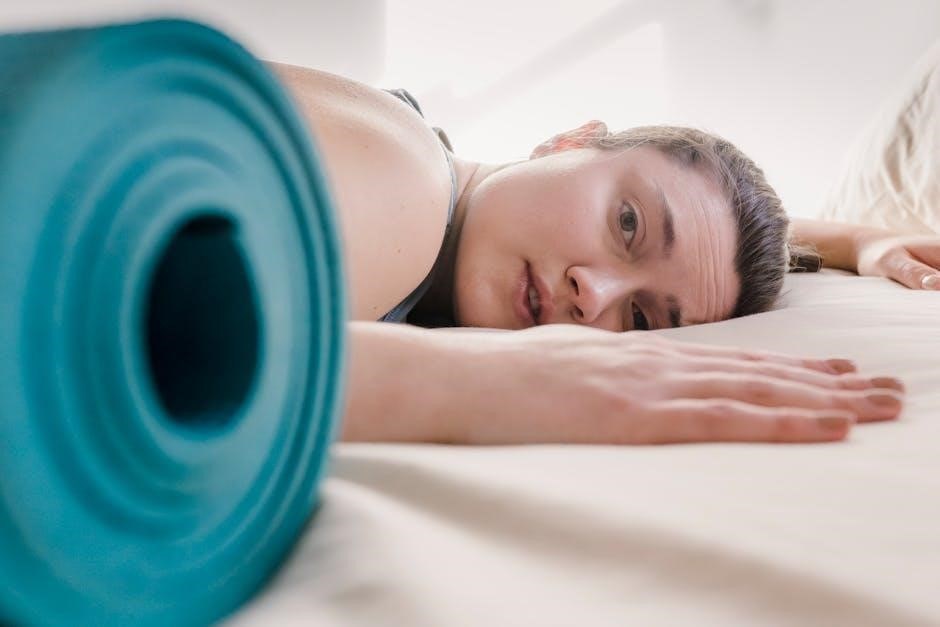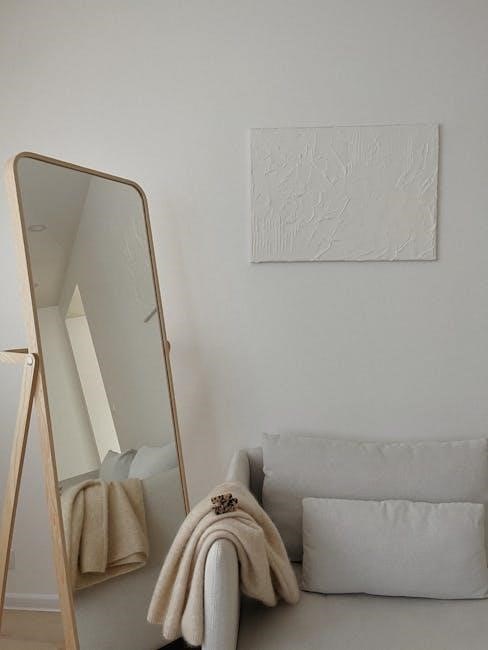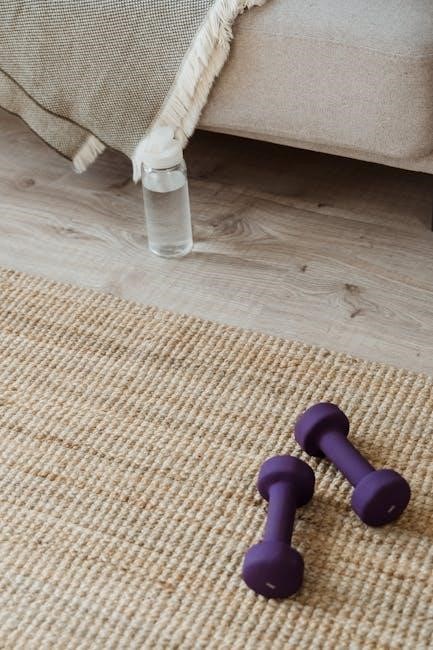Weighted blankets are therapeutic tools designed to provide deep pressure stimulation, promoting relaxation and improving sleep quality. They offer a calming, gentle hug-like sensation, ideal for reducing anxiety and stress.
1.1 What Is a Weighted Blanket?
A weighted blanket is a specially designed therapeutic blanket filled with materials like polypropylene pellets, glass beads, or sand, adding extra weight. The blanket applies gentle, evenly distributed pressure to the body, mimicking the comforting sensation of a hug. This deep pressure stimulation (DPS) is intended to promote relaxation, reduce anxiety, and improve sleep quality. Unlike regular blankets, weighted blankets are designed to provide a calming effect without feeling restrictive. They are typically used for sleep but can also be used for relaxation during the day. The weight is distributed evenly, ensuring a soothing experience tailored to individual needs.

How Weighted Blankets Work
Weighted blankets apply gentle pressure using materials like beads or pellets, creating a calming effect that mimics a reassuring hug, helping users relax and unwind naturally.
2.1 The Science Behind Deep Pressure Stimulation (DPTS)
Deep Pressure Stimulation (DPTS) is a therapeutic technique that applies gentle, distributed pressure to the body. This stimulation triggers the brain to release serotonin, a calming hormone, which helps reduce stress and anxiety. The pressure also promotes melatonin production, improving sleep quality. DPTS mimics the comforting feeling of a hug, activating the parasympathetic nervous system to induce relaxation. Weighted blankets use this principle, incorporating materials like beads or pellets to provide even pressure. The result is a soothing, grounding sensation that calms the mind and body, making it easier to fall asleep and stay asleep. This science-backed approach has made weighted blankets a popular tool for enhancing mental and physical well-being.
Benefits of Using a Weighted Blanket
Weighted blankets provide a calming effect, improving sleep quality and reducing anxiety. They promote relaxation, alleviate stress, and enhance mental well-being through gentle, constant pressure.
3.1 Improving Sleep Quality
Weighted blankets enhance sleep quality by providing a calming, grounding sensation that reduces restlessness and anxiety. The deep pressure stimulation encourages the body to relax, making it easier to fall asleep and stay asleep. This can lead to deeper sleep stages, improving overall restfulness. Many users report feeling more refreshed and energized after using a weighted blanket. However, it’s important to ensure the blanket isn’t too heavy, as this could disrupt sleep. For children, weighted blankets should be used safely, ensuring they can move freely and the blanket is removed once they fall asleep to prevent overheating. Proper use can significantly enhance sleep quality.
3.2 Reducing Anxiety and Stress
Weighted blankets are highly effective in reducing anxiety and stress by applying gentle, constant pressure that mimics a comforting hug. This deep pressure stimulation (DPTS) activates the brain’s production of serotonin, a neurotransmitter that regulates mood and relaxation. The calming effect can help individuals with anxiety feel grounded and secure, reducing feelings of restlessness. For many, the weighted blanket becomes a go-to tool for unwinding after a stressful day. It’s particularly beneficial for those who struggle with anxiety-related insomnia, as the blanket’s soothing impact can ease racing thoughts and promote emotional calmness. Regular use can lead to a significant reduction in stress levels.

Choosing the Right Weighted Blanket
Selecting the right weighted blanket involves considering weight, size, and material to ensure comfort and effectiveness. Using a weighted blanket calculator can help determine the ideal fit.
When choosing a weighted blanket, consider weight, size, and material. Weight should be 10% of the user’s body weight for optimal comfort. Size should fit the user’s body, avoiding overly large blankets for children. Material affects breathability and comfort; cotton is breathable, while minky is soft. For children, breathable materials are recommended for safety. Adults can opt for larger sizes based on personal preference. Avoid overly heavy blankets, as they may cause discomfort or restriction. Proper fit ensures the blanket provides the intended calming benefits without compromising safety or comfort. Always prioritize quality and suitability for the intended user. A weighted blanket weight calculator simplifies choosing the right weight by following the general rule of 10% of the user’s body weight. To use it, select pounds or kilograms, enter the user’s weight, and specify if the blanket will be shared. The calculator provides the ideal weight range, ensuring comfort and safety. For example, a 40-pound child might need a 5-6 lb blanket, while a 200-pound adult could use a 20-pound blanket. Some calculators also consider personal preferences or health conditions. Using a calculator helps avoid guesswork, ensuring the blanket is neither too light nor too heavy for optimal benefits. Always consult a healthcare provider for specific needs. Weighted blankets for adults are typically recommended at 10% of body weight, with a maximum of 35 pounds to avoid discomfort. Adults can choose sizes based on personal preference or bed size. For children, the 10% rule applies, but safety is crucial. Children under three should not use weighted blankets, and those under six should use shorter blankets (around 44 inches). Parents should consult a healthcare provider to ensure the blanket is safe and effective for their child. Always prioritize breathability and ease of movement, especially for younger users, to prevent overheating or restriction. This ensures the blanket is both beneficial and safe for all ages. Weighted blankets should not be used for babies under one year. Ensure the blanket is breathable to prevent overheating and avoid weights exceeding 35 pounds to prevent restriction. Weighted blankets are not recommended for babies under one year. Children under three should avoid them due to suffocation risks. For older children, ensure the blanket is breathable and follows the 10% body weight rule. Choose sizes no longer than 44 inches for those under six. Always supervise children using weighted blankets and ensure they can remove it independently. Never leave a weighted blanket on a sleeping child. Parents should consult a physician before introducing a weighted blanket to a child. Safety and comfort should always be prioritized to avoid any potential risks. Choosing the right weight is crucial for comfort and safety. A weighted blanket should not exceed 10% of the user’s body weight, with a maximum recommended weight of 35 pounds for adults. Blankets that are too heavy can cause discomfort, restrict movement, or lead to feelings of suffocation. If a blanket feels overly restrictive or causes anxiety, it is likely too heavy. Users should prioritize a weight that provides a soothing, calming effect without compromising freedom of movement. Always select a blanket that aligns with the user’s size and needs to ensure a safe and beneficial experience. Proper weight selection is key to enjoying the full benefits of a weighted blanket. A weighted blanket should gently wrap around your body, applying even pressure to promote relaxation. Use it for sleep or while resting to enhance calmness and comfort. For first-time users, start with a lighter weight to adjust to the sensation. Use the 10% rule as a guide for your body weight. Begin with short sessions, like 20 minutes, to gauge comfort. Place the blanket on your torso for the best calming effect. Avoid covering your head or overheating by using breathable materials. Start on a couch or chair to get used to the weight before sleeping. If you feel anxious or claustrophobic, remove it immediately. Consult a doctor if unsure, especially for children or sensitive individuals. This ensures a safe and beneficial experience. Sharing a weighted blanket can be enjoyable but requires careful consideration. Ensure the blanket is large enough to cover both users comfortably without feeling cramped. Use a weighted blanket designed for two people, typically heavier and larger. Choose a blanket with a removable, washable cover for hygiene. Opt for materials that breathe to prevent overheating. Avoid using a blanket too heavy for either person, as it may cause discomfort. If one person prefers more weight, consider separate blankets. Always prioritize comfort and safety, ensuring neither feels restricted or anxious. Sharing can enhance relaxation but should be tailored to both users’ needs. Weighted blankets are versatile tools that extend beyond sleep. They can be used for relaxation during meditation, reading, or watching TV. The deep pressure stimulation provides calming benefits, reducing anxiety and stress. Many people use weighted blankets while working or studying to improve focus and reduce restlessness. They are also ideal for travel, offering comfort during long flights or car rides. Additionally, weighted blankets can be incorporated into yoga practices or used as a soothing companion during emotional distress. Their portability and therapeutic effects make them a practical choice for various non-sleeping activities, enhancing overall well-being and emotional balance throughout the day. To maintain your weighted blanket, wash the removable cover regularly and spot clean the weighted section. Avoid machine washing the weighted part; hand wash gently if needed. Air dry to prevent damage. Store the blanket flat or roll it to avoid creasing. Use mild detergents and avoid harsh chemicals. Regular maintenance ensures longevity and hygiene. Proper washing and maintenance are crucial to extend the life of your weighted blanket. Always check the care label for specific instructions, as materials may vary. For most blankets, remove the outer cover and wash it in cold water using a gentle detergent. Avoid using bleach or fabric softeners, as they can damage the fabric. Gently scrub stains and rinse thoroughly. Air dry the cover to prevent shrinkage or damage. For the weighted insert, spot clean with a damp cloth and mild soap. Never submerge the weighted section in water, as it can damage the filling. Regular maintenance ensures hygiene and comfort, keeping your blanket fresh and functional for years. Weighted blankets have emerged as a powerful tool for improving sleep quality, reducing anxiety, and enhancing overall well-being. By understanding how they work, selecting the right size and weight, and following safety guidelines, users can maximize their benefits. Proper care and maintenance ensure longevity, while responsible usage, especially for children, is essential. Whether you’re seeking better rest or relief from stress, a weighted blanket can be a valuable addition to your daily routine, promoting relaxation and comfort. With the right approach, it can become a trusted companion for improving your mental and physical health, helping you achieve a deeper, more restorative sleep.4.1 Factors to Consider: Weight, Size, and Material
4.2 Using a Weighted Blanket Weight Calculator
4.3 Recommendations for Adults vs. Children

Safety Precautions
5.1 Guidelines for Children and Babies
5.2 Avoiding Overly Heavy Blankets
How to Use a Weighted Blanket Correctly
6.1 Tips for First-Time Users
6.2 Sharing a Weighted Blanket
6.3 Using a Weighted Blanket for Non-Sleeping Purposes

Caring for Your Weighted Blanket
7.1 Washing and Maintenance Tips